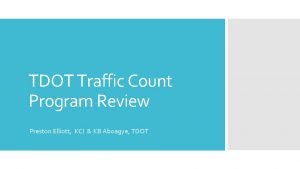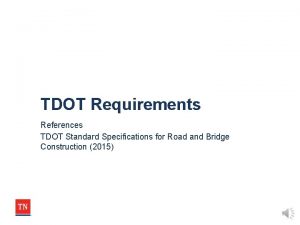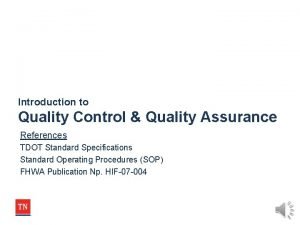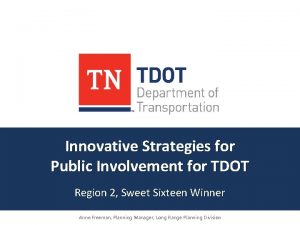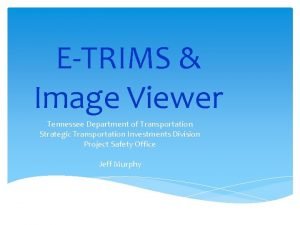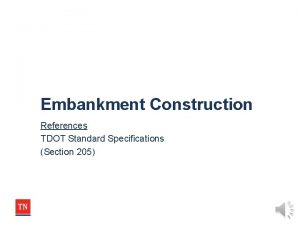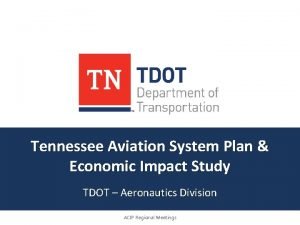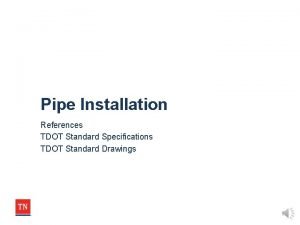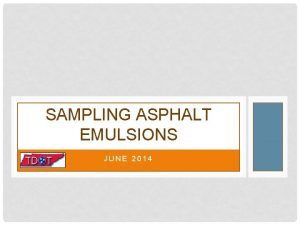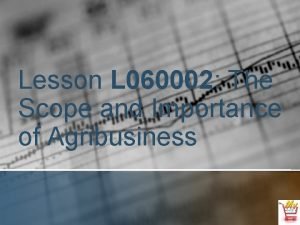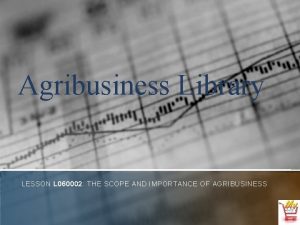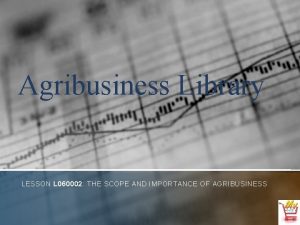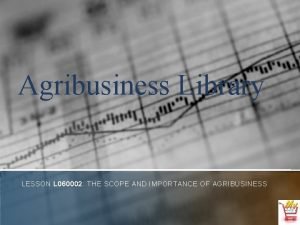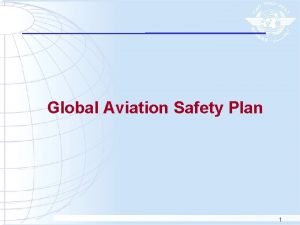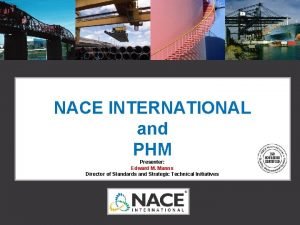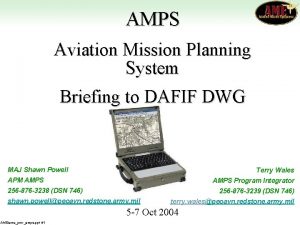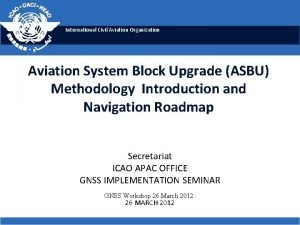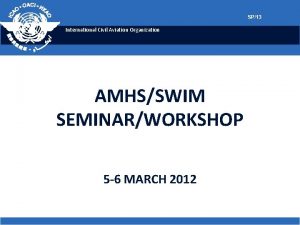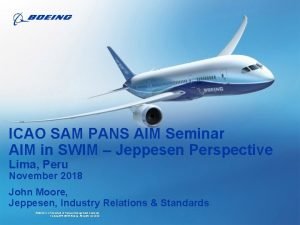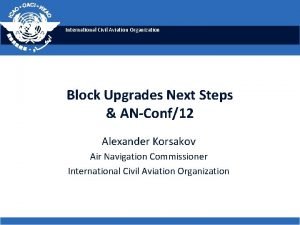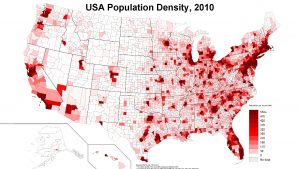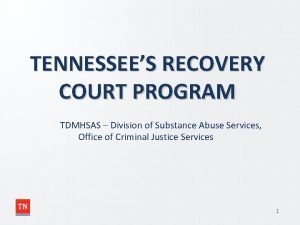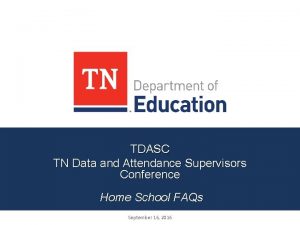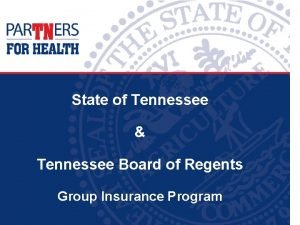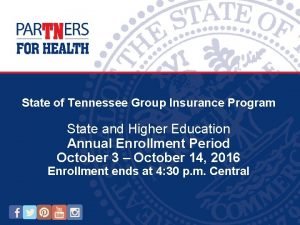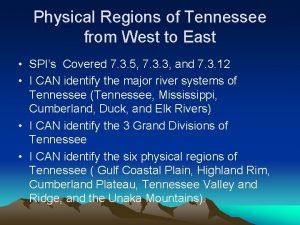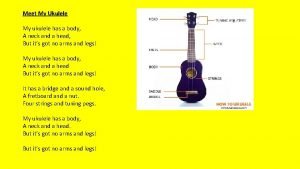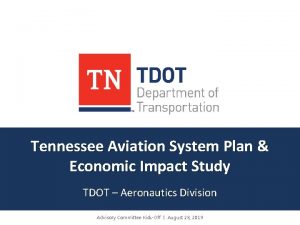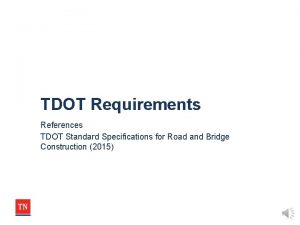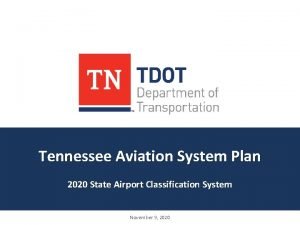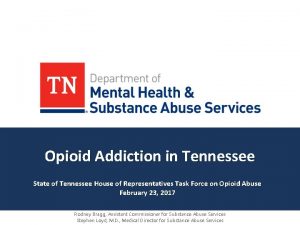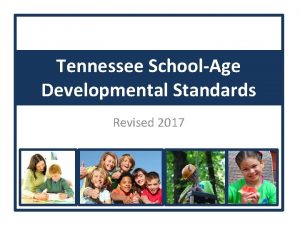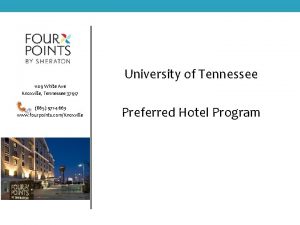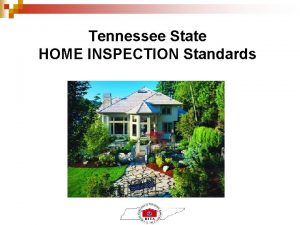Tennessee Aviation System Plan Economic Impact Study TDOT














































- Slides: 46

Tennessee Aviation System Plan & Economic Impact Study TDOT – Aeronautics Division ACIP Regional Meetings

Introductions • TDOT – Aeronautics Division • Consultant Team ▫ Kimley-Horn – – EDR Garver Marr Arnold Connico • Advisory Committee (AC) Members 2

Agenda • Project Overview ▫ Tennessee Aviation System Plan (TASP) ▫ Economic Impact Study • • Project Goals and Performance Measures (PMs) Economic Impact Data Organization Inventory Survey Discussion 3

Project Overview 4

TASP Study Components Tennessee Aviation System Plan Establish the Needs Economic Impact Study Support the Needs

Purpose of the TASP • Establish the Goals and Performance Measures for the entire state • Collect data statewide relevant to understanding the project Goals • Based on data collection, identify statewide system needs ▫ Base these needs on right-sizing projects at airports to support both residents and visitors ▫ Establish framework for state decision making

The TASP is not… • A plan to replace individual airport ACIPs or planning and design efforts • Meant to instruct airports how to do business with TDOT – Aeronautics Division • A mandate that a project will be funded (recommendations only)

TASP Process Establish Goals, Performance Measures, and Indicators Public Consultation Inventory of System Condition & Performance Forecast Activity and System Requirements Explore Aviation Issues and Identify System Needs Review Existing NPIAS and Non. NPIAS Airport Roles/Classifications Analysis of System Alternatives Review of Environmental Considerations Determine System Performance Develop Systemwide Cost Estimate and Implementation Plan Intermodal Considerations Policy and Investigation Recommendations Deliverables 8

Purpose of an Economic Impact Study • Quantitative Impact Calculation ▫ What is the economic contribution of Tennessee’s airports? ▫ What is the value of key aviation activities supported by Tennessee’s airports? – Agricultural activity – Freight and cargo • Qualitative Impacts ▫ Quality of life factors – tell the story of the aviation system’s importance – Medical evacuation – Aerial firefighting, and more 9

Economic Impact Study Process Quantitative Data Collection Qualitative Data Collection (real-life stories) Calibrate Economic Model Calculate Aviation Economic Impacts Deliverables

Project Goals and PMs 11

What Drives the TASP? System Goals Performance Measures Facility & Service Targets System Recommendations

Goals of the TASP Goal 1: Protect and preserve existing airport infrastructure by prioritizing airport system needs. Goal 2: Provide an airport system with available and cost-efficient transportation options for moving people and freight. Goal 3: Improve the safety and security of airport system users. Goal 4: Maximize federal, state, and local resources to meet the airport system needs and minimize environmental impacts. Goal 5: Invest in the airport system and the aviation workforce to support economic growth and competitiveness. 13

14

15

Facility and Service Targets Assess the current facilities and services provided Recommend projects through the TASP to meet facility and service targets Develop airports to meet identified facility and service targets Current Condition Implementation of the TASP Facility and Service Targets Aspirational – Develop to meet targets over a 20 year development cycle

Turf 17

Economic Impact 18

Study Needs • Economy and population experiencing significant growth • Commercial service environment changing with more flight options – new commercial service, larger aircraft, more passengers • Current data collection • Multi-Regional Analysis 19

Breadth of Study AREAS OF ANALYSIS STATE REGIONAL AIRPORT GENERAL TARGET AUDIENCES & USEFULNESS Statewide policy makers; presents contributions of public-use airports to the statewide economy Regional policy makers, chambers of commerce, other business associations, and regional audiences; present more localized contributions of aviation to regional economies Local communities and municipal policy makers; emphasize the direct economic role of airports in local economies Elements appeal to the general public of localities, regions and across Tennessee 20

Example of the Multi-Regional Analysis for Airports Regional Impacts TN Region 1 Sum of impacts within TN Region 1 On-Airport Activity Visitor Spending In-Region Multiplier Effects + Multi-Regional Impacts REST OF TN Sum of impacts in all other Regions Additional Multiplier Effects Statewide Impacts = TOTAL ECONOMIC CONTRIBUTION to the Economy 21

Quantifiable Components of Aviation Economic Impacts AIRPORT-SPECIFIC 1 Airport Operations (Airport Administration) 2 Airport Tenants/Businesses with Employees 3 Construction (Capital Investment) 4 Visitor Spending REGIONAL/STATEWIDE 5 Businesses w/Based Aircraft 6 Other Companies Reliant on Aviation 22

Data Organization 23

Economic Impact Surveys SURVEYS Airport Management Airport Tenants Commercial Service Visitors GA Pilots/Visitors* Businesses with Based Aircraft Companies Reliant on Aviation *May be supplemented with surveys from other statewide and airport economic impact studies to build a more robust analysis. 24

On-Airport vs. Regional/State Level • On-Airport Level ▫ ▫ Administration Tenants Capital Improvements Visitors – Commercial Service – General Aviation • Region/State Level ▫ Industries using/relying on airports – Companies whose employees use airline service – Companies that use airports to bring customers to their offices in Colorado – Companies that use freight/cargo shipments – Companies with based aircraft at airport, but no employees at airport Entertainer/business owner who lives in town (full or part time) and relies on airport but has no employees at airport 25

On-Airport Impacts • Airport Administration ▫ Airport operations, management, and budget, which may include facility and ▫ grounds maintenance and other administrative needs. • Airport Tenants ▫ ▫ Airlines, FBOs, MROs, avionics and other aircraft service companies, terminal concessions (e. g. , restaurants and retailers), as well as on-airport warehouses/trucking, hotels, and other types of businesses that pay rent or fees to the airport and have establishments on airport property. May also include impacts of: – Surface transportation providers (companies that move passengers to and from airports including taxis, TNCs, private buses/vans and public transportation) – Air cargo (Fed. Ex/UPS/other) that operate at airport (off-airport freight/logistics are included in separate analysis) 26

On-Airport Impacts • Capital Improvements ▫ Impacts of capital improvements such as construction of airside and landside facilities. These expenditures include airport, federal, state and other funds, as well as tenant expenditures. The total improvements over the last 4 years are averaged to represent an “average year”. 27

Off-Airport Impacts (Airport Level) • Visitors (Commercial and GA Spending) ▫ Airports facilitate money from out-of-state being brought into Colorado. Impacts are generated by out-of-state visitors who arrive by air and spend money off-airport on lodging, retail, restaurants, entertainment and local transportation. (Note that airport rental cars are captured in the tenant analysis. ) Spending estimates for visitors using commercial or GA airports are collected by airport surveys and data providers (such as local/state tourism agencies). Ensure not duplicating the impacts of on-airport vs. off-airport spending. 28

Off-Airport Impacts (Region/State Level Only) • Businesses that are Air Reliant on Airports ▫ Measures extent companies located off-airport rely on airports for at least a portion of their business activities and explains how airports contribute to non- aviation economic development. Data are gathered from: – Surveys of businesses identified in airport management survey as reliant/using airports – Survey of 2, 000 businesses in industries that are known to be reliant on aviation – Survey of businesses with based aircraft identified in airport management survey 29

Industry Reliance May Include • Examples ▫ ▫ ▫ Service companies like consulting firms and technology service providers that make long distance trips for sales calls, servicing customers, and collaborating via air trips Companies that use airports to bring customers, investors or collaborators to their offices in Colorado Ongoing incoming or outgoing freight/cargo shipments May have based aircraft at airport, but no employees at airport Entertainer/business owner who lives in town (full or part time) and relies on airport but has no employees at airport • Reason for being a state/regional analysis: ▫ The survey results are often not reliable by airport and could have misleading results of the scales of contributions by specific airports. Double counting is a major problem, specifically with the cargo and based aircraft survey (which is often combined with the reliant analysis). Generally, this survey lends itself to qualitative analyses. 30

Impact Categories 31

Out-of-State Visitor Spending COMMERCIAL OUT-OF-STATE VISITORS GENERAL AVIATION OUT-OF-STATE VISITORS True Visitors/Transient Ops Visitors Enplanements Connecting Passengers Tennessee Residents Itinerant Ops Operations x Passengers per Operation Local Ops 32

Out-of-State Visitor Surveys • Define the level of spending per outof-state visitor off-airport for: ▫ ▫ ▫ Lodging Food/Drink Entertainment Local Transportation (excluding on-airport rental car) Retail Purchases 33

Presentation of Impacts Direct 34

Presentation of Impacts Total Impacts Jobs Payroll Value Added Business Revenues On-Airport Administration Tenants Capital Improvements Visitor Spending Commercial Service General Aviation Other Industry Reliance Total Region/Statewide Only 35

Sample Presentation of Findings 36

Inventory Survey Discussion 37

Inventory Process • Collect baseline data to: ▫ Benchmark current system facilities and services ▫ Evaluate historical system progress ▫ Conduct activity forecasts ▫ Calculate updated system performance ▫ Identify system needs Surveys Airport Follow-Up Data Compilation Analysis 38

Inventory Includes • • Airside/Landside Facilities Airport Services Airport Activity Mobility and Access Rates and Charges Airport Planning Environmental and Land Use Compatibility • Economic Impact 39

Data Collection Efforts and Timing • Inventory is the most time-intensive task in the system planning process • Bad data in = bad data out • 6 -month effort (January – June 2020) begins with inperson site visits • Economic Impact Study surveys will commence as airport manager surveys are returned ▫ ▫ Tenants (such as FBOs, flight training) Businesses that base aircraft Airport-reliant businesses (local and non-local) GA and commercial service visitor spending 40

Project Survey - TASP • • Airside Facilities Facility Use Landside Facilities Aviation Services Airport Activity Airport Access Airport Planning 41

Project Survey – Economic Impact Study • • • Airport Manager Survey Airport Tenant Survey Businesses w/ Based Aircraft Survey Business Reliance Survey Visitor Spending ▫ General Aviation ▫ Commercial Service 42

Project Survey – Rates and Charges • Airport Tie-Downs • Airport Hangar Leases ▫ Box ▫ Corporate ▫ T-Hangar • • • Ground Leases Miscellaneous Leases FBO Leases Through the Fence Agreements Special Event Agreements Advertising 43

Next Steps • • Conduct airport manager surveys Draft goals and performance measure chapter Deploy economic impact surveys Next AC meeting – Spring 2020, alongside an existing TAC meeting

Questions? • Evan Lester, TDOT – Aeronautics Division Project Manager – 615 -361 -8016 – Evan. Lester@tn. gov • Zach De. Veau, Kimley-Horn Project Manager – 850 -553 -3530 – Zach. De. Veau@kimley-horn. com

THANK YOU! 46
 Tdot traffic count
Tdot traffic count Tdot standard specifications
Tdot standard specifications Tdot sop 1-1
Tdot sop 1-1 Tdot regions map
Tdot regions map Etrims
Etrims Tdot standard specifications
Tdot standard specifications Tdot aeronautics
Tdot aeronautics Tdot standard specifications
Tdot standard specifications Tdot sop 1-1
Tdot sop 1-1 Positive impact of economic in tourism
Positive impact of economic in tourism When did the pax romana begins.
When did the pax romana begins. Scope of agribusiness
Scope of agribusiness What is the scope and economic impact of agribusiness
What is the scope and economic impact of agribusiness What is the scope and economic impact of agribusiness?
What is the scope and economic impact of agribusiness? What is the scope and economic impact of agribusiness
What is the scope and economic impact of agribusiness Pax romana augustus
Pax romana augustus Global aviation safety plan
Global aviation safety plan Economic growth vs economic development
Economic growth vs economic development Economic growth and development
Economic growth and development Economic systems lesson 2 our economic choices
Economic systems lesson 2 our economic choices Nace impact study
Nace impact study Nace impact study
Nace impact study Aviation mission planning system (amps)
Aviation mission planning system (amps) Aviation system block upgrades asbu
Aviation system block upgrades asbu Asbu aviation system block upgrades
Asbu aviation system block upgrades Pans aim
Pans aim Aviation system block upgrades
Aviation system block upgrades Impact plan template
Impact plan template Tennessee population density map
Tennessee population density map Themes in the glass menagerie
Themes in the glass menagerie The glass menagerie ppt
The glass menagerie ppt Tnwits
Tnwits Tennessee landforms
Tennessee landforms Tennessee state seal
Tennessee state seal Biology (tennessee) answers
Biology (tennessee) answers Tn data and attendance conference
Tn data and attendance conference Super2.tennessee
Super2.tennessee Www.tennessee.deltadental/stateoftn
Www.tennessee.deltadental/stateoftn State of tennessee payflex
State of tennessee payflex What is plastic theatre
What is plastic theatre 6 physical regions of tennessee
6 physical regions of tennessee Roadmap to success
Roadmap to success There once was a man from tennessee ukulele
There once was a man from tennessee ukulele What animal is on the top of the food chain
What animal is on the top of the food chain A streetcar named desire context
A streetcar named desire context Klasyfikacja tennessee hellp
Klasyfikacja tennessee hellp The new deal
The new deal
